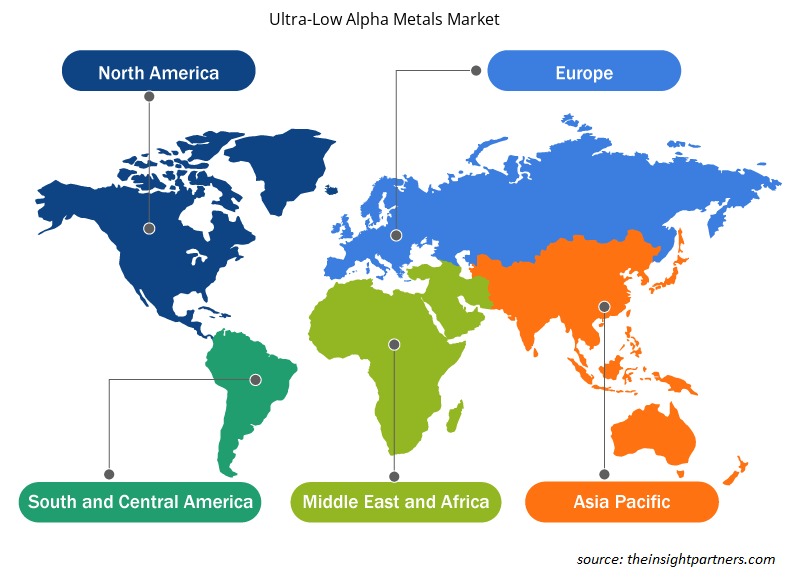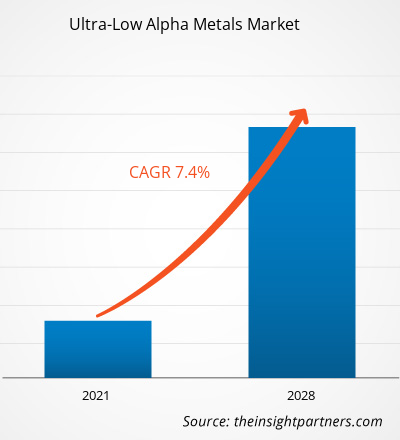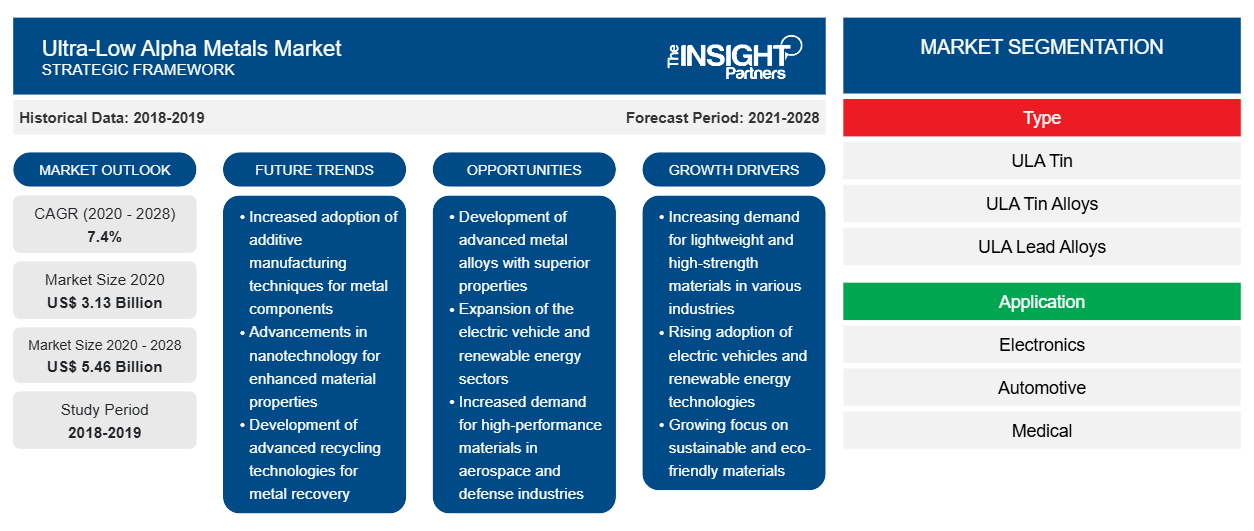[Rapport de recherche] Le marché des métaux à très faible teneur en alpha était évalué à 3 125,00 millions USD en 2020 et devrait atteindre 5 461,78 millions USD d'ici 2028 ; il devrait croître à un TCAC de 7,4 % de 2021 à 2028.CAGR of 7.4% from 2021 to 2028.
Les métaux à très faible teneur en alpha sont principalement utilisés dans les soudures par points dans l'industrie électronique. Les réglementations gouvernementales strictes sur l'utilisation de substances dangereuses dans les équipements électroniques stimulent la croissance du marché des métaux à très faible teneur en alpha. Cependant, la volatilité des prix des matières premières freine la croissance du marché.
En 2020, l’Asie-Pacifique a contribué à la plus grande part du marché mondial des métaux à très faible teneur en alpha .La croissance du marché dans la région est principalement attribuée à la présence d'une base industrielle solide avec des fabricants de premier plan. La forte demande de métaux à très faible teneur en alpha provenant d'applications telles que l'électronique, l'automobile et le médical, soutenue par des bases industrielles d'utilisation finale en forte croissance, stimule la croissance du marché des métaux à très faible teneur en alpha dans la région.
Personnalisez ce rapport en fonction de vos besoins
Vous bénéficierez d'une personnalisation gratuite de n'importe quel rapport, y compris de certaines parties de ce rapport, d'une analyse au niveau des pays, d'un pack de données Excel, ainsi que de superbes offres et réductions pour les start-ups et les universités.
-
Obtenez les principales tendances clés du marché de ce rapport.Cet échantillon GRATUIT comprendra une analyse de données, allant des tendances du marché aux estimations et prévisions.
Impact de la pandémie de COVID-19 sur le marché des métaux à très faible teneur en alpha
La pandémie de COVID-19 en cours a radicalement modifié le statut du secteur des produits chimiques et des matériaux et a eu un impact négatif sur la croissance du marché des métaux alpha ultra-faibles. La mise en œuvre de mesures pour lutter contre la propagation du nouveau coronavirus a aggravé la situation et a fait baisser la demande de métaux et de matériaux industriels. Les opérations des industries ont été impactées par la pandémie, ce qui a finalement perturbé le cycle de livraison et augmenté les tarifs douaniers d'import-export. La distorsion soudaine de l'efficacité opérationnelle et les perturbations des chaînes de valeur sont attribuées à la fermeture soudaine des frontières nationales et internationales et à la fermeture temporaire des bases de fabrication en raison de confinements indéfinis et de quarantaines temporaires, qui ont entravé la croissance du marché pendant la pandémie. Les restrictions sur la chaîne d'approvisionnement avec la volatilité des prix et de l'approvisionnement des matières premières en raison des premières semaines de confinement ont perturbé les produits et les processus industriels. En outre, l'accent mis sur la production juste à temps est un autre facteur préoccupant qui entrave la croissance du marché. Cependant, alors que les économies envisagent de relancer leurs activités, la demande de métaux à très faible teneur en alpha devrait augmenter à l'échelle mondiale dans les années à venir. La demande croissante de matériaux industriels avancés en raison de la croissance de diverses industries d'utilisation finale, telles que l'électronique, l'aérospatiale et la défense, l'automobile, la médecine et les télécommunications, devrait également stimuler la croissance du marché dans les années à venir. En outre, les investissements importants des principaux fabricants dans le développement d'alliages sans plomb à très faible teneur en alpha alimenteraient la croissance du marché des métaux à très faible teneur en alpha au cours de la période de prévision.lockdowns and temporary quarantines, which have hampered the growth of the market during the pandemic. The restrictions on supply chain with volatility in raw material pricing and sourcing due to initial weeks of lockdown have disturbed the industrial products and processes. Also, the focus on the just-in-time production is another concerning factor hindering market growth. However, as the economies are planning to revive their operations, the demand for ultra-low alpha metals is expected to rise globally in the coming years. The increasing demand for advanced industrial materials due to the growth of various end-use industries, such as electronics, aerospace & defense, automotive, medical, and telecommunication, is also expected to drive the growth of the market in the coming years. Further, significant investments by prominent manufacturers in the advancement of ultra-low alpha lead-free alloys would fuel the growth of the ultra-low alpha metals market during the forecast period.
Informations sur le marché
L'augmentation des inquiétudes concernant le problème des erreurs logicielles pourrait alimenter la croissance du marché des métaux à très faible teneur en alpha
La demande croissante de produits à haute densité et à faible consommation a propulsé le concept de réduction des dimensions et des tensions de fonctionnement des appareils électroniques modernes. L'évolution constante des technologies complémentaires de dispositifs métal-oxyde-semiconducteur a conduit à la miniaturisation et à la réduction de la tension de fonctionnement des transistors des appareils. Cependant, le concept a ouvert de nouveaux défis, tant du point de vue de la technologie que des matériaux. L'un de ces problèmes est l'erreur logicielle, le dysfonctionnement temporaire de l'appareil, qui est causé par le rayonnement de particules alpha à haute énergie. L'une des principales sources de rayonnement des particules alpha est la soudure qui est largement utilisée pour joindre les composants dans le boîtier. Par conséquent, la préoccupation croissante à l'égard du problème de l'erreur logicielle a conduit à une augmentation de la demande de métaux à très faible teneur en alpha.
Informations sur les types
En fonction du type, le marché mondial des métaux à très faible teneur en alpha est segmenté en étain ULA, alliages d'étain ULA, alliages de plomb ULA, alliages sans plomb ULA et autres. Le segment des alliages sans plomb ULA et autres a dominé le marché en 2020. Avec les investissements croissants dans les activités de recherche et développement, les fabricants proposent des formes avancées de produits, qui pourraient répondre aux exigences spécifiques de l'industrie. De même, les fabricants ont introduit des alliages sans plomb ULA qui sont composés d'une proportion significativement faible de plomb (c'est-à-dire 0,1 %) ou pas de plomb du tout. La demande d'alliages de soudure sans plomb à très faible teneur en alpha augmente en raison des préoccupations croissantes envers l'environnement.ULA tin, ULA tin alloys, ULA lead alloys, ULA lead-free alloys and others. The ULA lead-free alloys and others segment led the market in 2020. With the growing investments in research and development activities, manufacturers are coming up with the advanced forms of products, which could meet specific industry requirements. Similarly, manufacturers have introduced ULA lead-free alloys that is composed of a significantly low proportion of lead (i.e., 0.1%) or no lead at all. The demand for ultra-low alpha lead-free soldering alloys is rising due to the growing concerns toward the environment.
Informations sur les applications
En fonction des applications, le marché mondial des métaux à très faible teneur en alpha est segmenté en électronique, automobile, médical, télécommunications et autres. Le segment de l'électronique a dominé le marché en 2020. Il est impératif de déployer l'utilisation d'alliages et de métaux pouvant contenir une teneur en alpha ultra-faible lorsqu'ils sont utilisés dans des applications électroniques. L'utilisation de métaux à très faible teneur en alpha permet d'éviter tout dysfonctionnement causé par des erreurs logicielles dans les appareils électroniques. De plus, la réduction significative de la taille des appareils, ainsi que l'installation de matériaux de soudure à proximité des emplacements sensibles des appareils électroniques, génèrent le besoin de métaux à très faible teneur en alpha. La demande de métaux à très faible teneur en alpha dans la production d'électronique grand public augmente.
Quelques-uns des principaux acteurs opérant sur le marché mondial des métaux alpha ultra-faibles sont MITSUBISHI MATERIALS Corporation ; Teck Resources Limited ; Advanced Manufacturing Services (AMS) Ltd ; Pure Technologies ; Honeywell International Inc. ; DUKSAN Hi-Metal Co., Ltd ; et MacDermid Alpha Electronics Solutions.
Rapports en vedette
- Tendances industrielles progressistes sur le marché des métaux à très faible alpha pour aider les acteurs à développer des stratégies efficaces à long terme
- Stratégies de croissance des entreprises adoptées par les marchés développés et en développement
- Analyse quantitative du marché des métaux à très faible teneur en alpha de 2019 à 2028
- Estimation de la demande mondiale en métaux à très faible teneur en alpha
- Analyse PEST pour illustrer l'efficacité des acheteurs et des fournisseurs opérant dans l'industrie
- Développements récents pour comprendre le scénario concurrentiel du marché
- Tendances et perspectives du marché ainsi que facteurs qui stimulent et freinent la croissance du marché des métaux à très faible alpha
- Aide au processus de prise de décision en mettant en évidence les stratégies de marché qui sous-tendent l'intérêt commercial, conduisant à la croissance du marché
- La taille du marché des métaux alpha ultra-faibles à différents nœuds
- Aperçu détaillé et segmentation du marché, ainsi que la dynamique de l'industrie des métaux à très faible alpha
- Taille du marché des métaux à très faible teneur en alpha dans diverses régions avec des opportunités de croissance prometteuses
Aperçu régional du marché des métaux à très faible teneur en alpha
Les tendances régionales et les facteurs influençant le marché des métaux alpha ultra-faibles tout au long de la période de prévision ont été expliqués en détail par les analystes d’Insight Partners. Cette section traite également des segments et de la géographie du marché des métaux alpha ultra-faibles en Amérique du Nord, en Europe, en Asie-Pacifique, au Moyen-Orient et en Afrique, ainsi qu’en Amérique du Sud et en Amérique centrale.

- Obtenez les données régionales spécifiques au marché des métaux alpha à très faible teneur
Portée du rapport sur le marché des métaux alpha à très faible teneur
| Attribut de rapport | Détails |
|---|---|
| Taille du marché en 2020 | 3,13 milliards de dollars américains |
| Taille du marché d'ici 2028 | 5,46 milliards de dollars américains |
| Taux de croissance annuel composé mondial (2020-2028) | 7,4% |
| Données historiques | 2018-2019 |
| Période de prévision | 2021-2028 |
| Segments couverts |
Par type
|
| Régions et pays couverts |
Amérique du Nord
|
| Leaders du marché et profils d'entreprises clés |
|
Densité des acteurs du marché des métaux alpha ultra-faibles : comprendre son impact sur la dynamique des entreprises
Le marché des métaux alpha à très faible teneur connaît une croissance rapide, tirée par la demande croissante des utilisateurs finaux en raison de facteurs tels que l'évolution des préférences des consommateurs, les avancées technologiques et une plus grande sensibilisation aux avantages du produit. À mesure que la demande augmente, les entreprises élargissent leurs offres, innovent pour répondre aux besoins des consommateurs et capitalisent sur les tendances émergentes, ce qui alimente davantage la croissance du marché.
La densité des acteurs du marché fait référence à la répartition des entreprises ou des sociétés opérant sur un marché ou un secteur particulier. Elle indique le nombre de concurrents (acteurs du marché) présents sur un marché donné par rapport à sa taille ou à sa valeur marchande totale.
Les principales entreprises opérant sur le marché des métaux à très faible teneur en alpha sont :
- Société de matériaux Mitsubishi
- Ressources Teck Limitée
- Services de fabrication avancés (AMS) Ltd
- Technologies pures
- Honeywell International Inc.
Avis de non-responsabilité : les sociétés répertoriées ci-dessus ne sont pas classées dans un ordre particulier.

- Obtenez un aperçu des principaux acteurs du marché des métaux à très faible teneur en alpha
Marché mondial des métaux à très faible teneur en alpha
Par type
- Boîte ULA
- Alliages d'étain ULA
- Alliages de plomb ULA
- Alliages sans plomb ULA et autres
Par application
- Électronique
- Automobile
- Médical
- Télécommunication
- Autres.
Profils d'entreprise
- Société Mitsubishi Materials
- Ressources Teck Limitée
- Services de fabrication avancés (AMS) Ltd
- Technologies pures
- Honeywell International Inc.
- DUKSAN Hi-Metal Co., Ltd
- Solutions électroniques Alpha de MacDermid
- Analyse historique (2 ans), année de base, prévision (7 ans) avec TCAC
- Analyse PEST et SWOT
- Taille du marché Valeur / Volume - Mondial, Régional, Pays
- Industrie et paysage concurrentiel
- Ensemble de données Excel
Rapports récents
Témoignages
Raison d'acheter
- Prise de décision éclairée
- Compréhension de la dynamique du marché
- Analyse concurrentielle
- Connaissances clients
- Prévisions de marché
- Atténuation des risques
- Planification stratégique
- Justification des investissements
- Identification des marchés émergents
- Amélioration des stratégies marketing
- Amélioration de l'efficacité opérationnelle
- Alignement sur les tendances réglementaires























 Obtenez un échantillon gratuit pour - Marché des métaux à très faible alpha
Obtenez un échantillon gratuit pour - Marché des métaux à très faible alpha